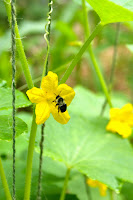 It's 'bean' crazy keeping up with the bean harvest this past week. I put in 54 bush bean plants in one of the raised beds this year (9 plants per square). In the past years I put in maybe 8 and would only get enough beans for a couple of dinners. I really wanted to be able to freeze some beans this year. It looks like I will be busy cooking and freezing this week.
It's 'bean' crazy keeping up with the bean harvest this past week. I put in 54 bush bean plants in one of the raised beds this year (9 plants per square). In the past years I put in maybe 8 and would only get enough beans for a couple of dinners. I really wanted to be able to freeze some beans this year. It looks like I will be busy cooking and freezing this week.
 How to freeze Green Beans...
How to freeze Green Beans...1)Trim off ends of beans and rinse
2) Bring large pot of water to boil
3) Prepare a large bowl of ice water with enough room to throw beans in
4) Toss beans into boiling water and let them blanch for 3-7 minutes (the beans should be bright green)
5) Quickly Strain the beans and then put them into the bowl with ice water. Cool them for the same length of time that you blanched them. The cold water stops them from cooking.
6) Strain the beans
7) But beans into freezer Ziploc bags and use a straw to suck out any extra air or use a vacuum sealer.
The beans should last up to 7 months in the freezer...so make sure to date them!
On a side note: You can do this with beans from your local farmers market. Just make sure they were harvested within 48 hours of going to the market. If beans aren't fresh, they become rubbery.




















